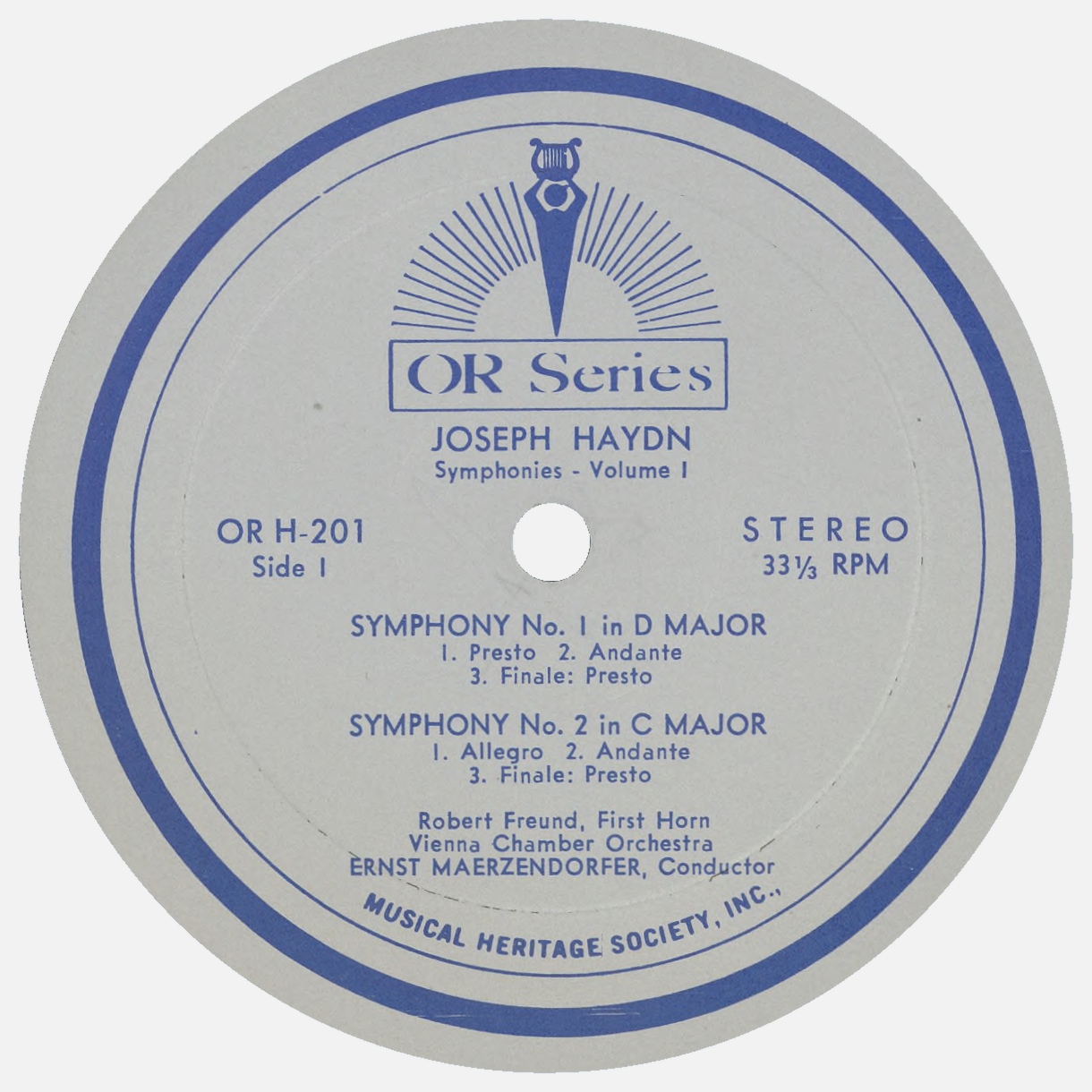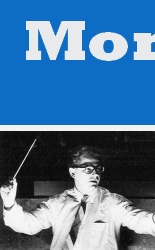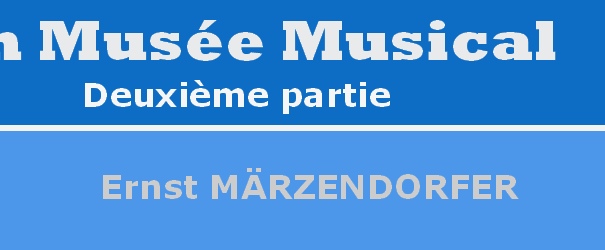Joseph HAYDN
Symphonie No 3 en sol majeur
Orchestre de Chambre de Vienne
Ernst MÄRZENDORFER
The Musical Heritage Society Inc. OR H-201
Dans les années 1960 (*), Ernst MÄRZENDORFER (son portrait à gauche devrait être contemporain de cette période) enregistra l'intégrale des symphonies de Joseph Haydn avec l'Orchestre de chambre de Vienne (Wiener Kammerorchester) pour le label Musical Heritage Society. Pour plus de détails sur cette intégrale voir les excellentes publications de Christopher HOWELL sur les pages suivantes de MusicWeb International: 1ère partie, 2e partie.
[*] Je n'ai pas encore pu trouver de datation précise pour l'enregistrement et la publication des symphonies de Haydn sous la direction de Märzendorfer: si une personne visitant cette page en sait plus, toutes informations m'intéressent -> couriel!
Cette troisième symphonie de Joseph Haydn est parmi les premières du 2e groupe de ses symphonies tel que défini par James WEBSTER en 1990:
Elle occupe une place particulière parmi les premières symphonies de Haydn. L'oeuvre montre déjà des traits „modernes“ de ce qui sera plus tard connu comme étant la symphonie typique du classicisme viennois, et est de ce fait considérée comme très importante dans l'oeuvre de Joseph Haydn:
"[...] The Symphony No. 3 in G major [...] has the four movements of later symphonies, as a minuet, borrowed from the divertimento of Haydn’s time, is inserted between Andante and Finale. Moreover the musical language is stricter, frequently divesting itself of the playful superficiality of the Rococo.
The initial Allegro is in 3/4 time, an unusual feature in symphonies of the period. Four long notes, appearing like a motto, head the movement, while violas and basses add an energetic countermelody. Haydn explores the possibilities of this unusual idea throughout the Allegro, introducing it in various transpositions and assigning it even to the bass.
The following Andante moderato is a slow march imbued with melancholy and sorrow. Its sighs and exclamations evoke the expressive style of sensibility which was to play an important role in Haydn’s later compositions.
In the Minuet strict canonic imitation between the violins and the lower-pitched string instruments is introduced, a feature likewise anticipating Haydn’s future output. The Trio with its delicate pastel colors offers the wind instruments an opportunity to engage in a nostalgic dialogue with the violins.
The last movement, Alla Breve, surprises us by the introduction of a brilliant double fugue. Various contrapuntal devices are expertly combined, creating a closely knit piece which is basically different from the light dance finales of the era. Haydn received the inspiration to this movement from works written long before his time; on the other hand the striking Alla Breve of the young composer foreshadows the masterwork of the genre, the Finale of Mozart’s "Jupiter Symphony,” conceived a quarter of a century later. [...]" cité des notes de Karl GEIRINGER publiées au verso du disque OR H-201
Pour une analyse détaillée, voir cette page en allemand de Wikipedia.
Voir aussi l'extrait des notes historiques de Howard Chandler ROBBINS LANDON reproduit au bas de cette page.
Dans les années 1960 (*), Ernst MÄRZENDORFER (son portrait à gauche devrait être contemporain de cette période) enregistra l'intégrale des symphonies de Joseph Haydn avec l'Orchestre de chambre de Vienne (Wiener Kammerorchester) pour le label Musical Heritage Society. L'enregistrement de la symphonie No 3 fut publié sur le disque Musical Heritage Society, OR Series (*), OR H-201: les symphonies No 1 et 2 sur la première face, les symphonies No 3 et 4 sur l'autre face..
[*] OR Series est l'abréviation de "Orpheus Series": noter la lyre - symbolisant Orphée - tenue par le personnage du logo sur la pochette et les étiquettes
Voici donc...
Joseph Haydn, Symphonie No 3 en sol majeur, Orchestre de Chambre de Vienne, Ernst Märzendorfer
 1. Allegro 03:32 (-> 03:32)
1. Allegro 03:32 (-> 03:32)
 2. Andante Moderato 04:19 (-> 07:51)
2. Andante Moderato 04:19 (-> 07:51)
 3. Menuet - Trio 03:15 (-> 11:06)
3. Menuet - Trio 03:15 (-> 11:06)
 4. Finale: Alla breve 01:53 (-> 12:59)
4. Finale: Alla breve 01:53 (-> 12:59)
Provenance: The Musical Heritage Society Inc., Orpheus Series OR H-201
que vous pouvez obtenir en...
pour un téléchargement libre
4 fichier(s) FLAC et 1 fichier PDF dans 1 fichier ZIP
Sur la symphonie No 3 de Joseph Haydn, cité des notes de Howard Chandler ROBBINS LANDON publiées en 1973 dans le 8e volume STS 15310-15 de l'intégrale des symphonies de Haydn enregistrées sous la direction d'Antal Dorati:
"[...] This is in many respects the most “modern” of all these early symphonies. The modernity comes, firstly, in the construction of the first movement, with a second subject in the dominant major and a delightful flourish for the oboes (thus introducing a contrast not only in key but also in instrumentation). Another aspect of this modernity is the fact that the work is in four movements with a full-fledged minuet and trio as the third movement: this is to set the pattern, after much wavering and second thoughts, for the mature Haydn. And paradoxically, another facet of the work's modernity is its oldfashioned use of counterpoint almost throughout. In fact Haydn’s mature style was to include, almost as second nature, a streak of Baroque contrapuntalism which continued through Mozart and was also cultivated by Beethoven, whose “Grosse Fuge” carries the art to ultimate splendour and complexity. We note that the theme of the opening movement lends itself to polyphonic treatment, giving the movement a multi-voiced richness that is immediately arresting. The second subject, with its oboe solos, and also the trio of the minuet, with its solos for oboes and horns, show strong traces of the Austrian divertimento.
The second movement is a fine G minor Andante moderato, very much beholden to the Austrian Baroque tradition.
But even more Baroque is the Menuet (as Haydn calls it), which turns out to be a canon between top and bottom lines at the interval of one bar: this created a furore at the time as was literally imitated — even to the actual key in the case of both imitators — by Michael Haydn and W.A. Mozart, but also by Joseph Haydn (in Symphony No.23, 1764).
The climax of all this preoccupation with contrapuntal forms is the Finale, which is a sturdy double fugue in the manner of J.J. Fux, the great Austrian Baroque composer whose contrapuntal treatise, Gradus ad Parnassum, was Haydn’s model (and of which Haydn made a brilliant extract for his pupils). Haydn’s is not a “straight” fugue, however, but is used in conjunction with elements of sonata form, e.g. modulation to the dominant. This fugal Finale is the great-grandfather of the Finale in Mozart’s Jupiter Symphony, but before 1788 Haydn himself will have refined the fugal last movement to an instrument of rare delicacy and strength. [...]"




